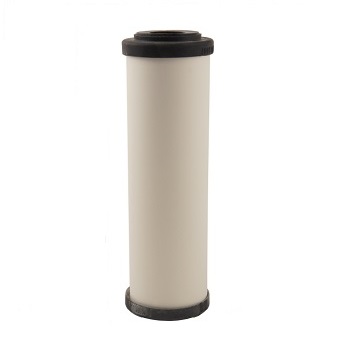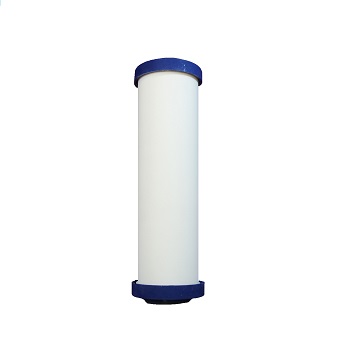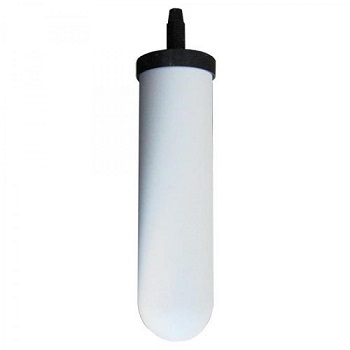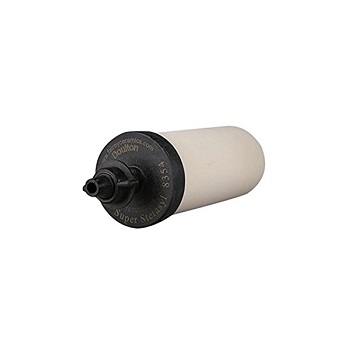
How To Clean Ceramic Water Filters
September 23, 2021 10:33 am Leave your thoughts
Has your ceramic water filter’s flow rate slowed down recently? You’ve reached the right place. This guide will explain how to restore the flow rate of a ceramic filter by simply cleaning it. Read on to learn more.
Ceramic water filters have become quite popular in the past few years due to the very fine level of filtration they can provide. The pores in a ceramic filter’s outer casing can be as small as 0.2 micron, which make them capable of blocking minute sediment particles, bacteria, algae, and metal particles.
Modern ceramic filters can also contain activated carbon, resin, KDF, and other forms of media which can reduce contaminants like chlorine, pesticides, volatile organic compounds, industrial solvents, and PFAS. This makes modern day ceramic filters a great option if you are looking for ultra-fine filtration.
Unfortunately, there is a downside to using ceramic filters. The fine outer shell of the filters mean can become clogged quickly if you are in an area with a high level of suspended sediment.
This can reduce the amount of water entering the filter which will negatively impact your flow rate. Fortunately, there is surprisingly simple fix to this issue – scrubbing it clean. Here is a quick overview of ceramic filters and how they should be cleaned.
Contents
Types of Ceramic Filters
Why Do Ceramic Filters Slow Down?
When Should You Clean Your Ceramic Filter?
How To Clean A Ceramic Water Filter
How Many Times Can You Clean A Ceramic FIlter?
Wrapping Up
Types Of Ceramic Filters

The modern form of the ceramic water filter was invented in 1827 by Henry Doulton. His design was a ‘candle’ type filter which acted as a mechanical sieve, filtering water in a dual chamber urn.
It was an innovative design that reduced bacteria, sediment, silt, sand, and several other contaminants. The design was so effective that they are still in use today. The only difference is that modern day candle filters usually contain activated carbon, to reduce chemical contaminants and improve the taste/odour of the water.
There are also cylindrical cannister-style ceramic filters, which are placed inside of filter housings. This type of ceramic filter usually contains additional types of filtration media inside the filter, like carbon, resin, or minerals.
Regardless of the shape of your ceramic filter, you can still clean it using the method below.
Why Do Ceramic Filters Slow Down?
Short answer – sediment build up.
The outer shell of a ceramic filter operates like a sieve. It has extremely fine pores which allow water through while blocking sediment, dirt, algae, and several other contaminants. Because the ceramic’s pores are so fine, particles as small as 0.2 microns can be trapped.
Over time, the trapped contaminants will build up on the ceramic surface. Eventually, it will get to the point where most of the filter’s ceramic pores are blocked. At this point, your flow rate will begin to slow down as water cannot penetrate the ceramic surface as easily.
If your water has a lot of sediment in it, your ceramic filters will clog up much faster. This is why we encourage customers with high-sediment water to place a sediment filter before their ceramic filter.
When Should You Clean Your Ceramic Filter?

You can clean your ceramic filter whenever you notice that the flow rate has dropped to the point where it takes too long to fill up your favourite drinking vessel.
It can also be a good idea to clean your filter after any event which may have pushed additional contaminants into the water. This might include nearby bushfires, work on nearby water pipes by your local council, or a dry spell forcing you to use sediment-heavy water in the bottom of your tanks.
These types of events can push more sediment into the water supply, which will impact the performance of your filter. By pre-emptively cleaning your filter you can maintain its flow rate and ensure optimal performance.
How To Clean A Ceramic Water Filter

Restoring the flow rate of your ceramic filter is simple. You just need to scour off the top layer of the ceramic housing to open up the pores again. Here’s how to do it:
What You Will Need:
Clean Hands
Always wash your hands before handling your ceramic filters. This reduces the risk of the filter being contaminated by bacteria and other particles which may be present on your skin. When handling your filter, you should also avoid touching the ceramic as much as possible. Instead, hold the filter by the plastic caps or thread on the bottom of the filter.
A Scouring Pad
A variety of abrasive objects can be used to clean the surface of ceramic filters. However, we recommend using a clean Scotch-Brite Scourer as it has the perfect level of abrasiveness for cleaning ceramic filters.
It is also flexible, so it can wrap around your cylindrical water filters. Scotch-Brite scourers are easy to find (Coles and Woolworths both sell them).
It’s important that you always use a clean scourer. The last thing you want to do is push fats, grime, and other contaminants from a dirty scourer into the pores of your ceramic water filter. Avoid using cheap scourers found as they often fall apart and leave fibres stuck to the filter.
As for other options, clean 80 grit sandpaper or a soft toothbrush is a fantastic way to go. You can even use the back of a butter knife, however you will need to be very gentle as there is more risk of damaging the filter or removing to much of the surface.
Clean Water
Running water is used to provide lubrication as you clean your ceramic filter.
A Towel
Used to catch any displaced water from your filtration system when you open it. It can also be used to provide a soft-landing surface for your filter if you drop it.
Filter Housing Spanner
If you have a cannister-style filter housing, find your filter spanner as it will make it easier to undo the sumps.
Time needed: 10 minutes
How To Clean A Ceramic Filter
- Gather your tools
Grab your Scotch-Brite scourer, towel, and spanner (if needed).
- Remove your filter from its housing or urn (carefully)
For urn systems: Simply unscrew the ceramic candle from inside the urn and detach the candle.
For cannister-type filters: Isolate the water filter by turning off your angled stop valve or shut off tap. Open up your water tap to release any water pressure in the filter system. Place a towel under your system to catch any excess water then use filter spanner to open the cannister and remove your filter.
Remember to sanitiser your hands before servicing your filter system. When you grab your filter, avoid touching its ceramic surface whenever possible. Instead, grasp it by the plastic cap (for cannister filters) or thread (for candles) on the end of the filter. This will limit the chance of any contamination. - Place a towel in the bottom of the sink (optional)
Ceramic filters are very fragile and can easily crack or break open if dropped onto a hard surface. For this reason, we recommend putting a towel in your sink. It will provide some cushioning for the filter if it slips out of your hand as you are cleaning it.
- Begin scouring
Position your filter under a running tap and gently scrub up-and-down along the length of the filter. If your flow rate has slowed to a trickle, you might need to use more force to remove the ceramic surface layer. Rotate the filter in your hand to reach all areas. Alternately, you can place the filter into a bowl filled with water and scrub it there.
- Rinse and re-install
Give your filter a final rinse off, then reinsert it into your urn or filter sump. If using a cannister-type system, be sure to only hand tighten the sump (the spanner is only for removing sumps).
How Many Times Can You Clean A Ceramic Filter?
You can scour the surface of a ceramic filter dozens of times before damaging it. However, eventually the ceramic outer shell will become too thin and fragile for it to be used effectively.
It’s also worth noting that the contents of the filter have a much shorter lifespan than the ceramic outer shell. If you have carbon or a fluoride reduction media inside the filter, they will reach maximum capacity much earlier than the ceramic shell becomes compromised.
So, even though the filter looks fine on the outside, the media inside the filter may not be working. That’s why we recommend changing out filters every 6 to 12 months.
Wrapping Up
Ceramic filters are one of the most effective options for removing contaminants from water. Their only major downside is that sediment can clog up the pores of the ceramic surface over time.
Now that you know how to clean your ceramic filters, this downside will no longer be a issue and you can enjoy a great flow rate from your ceramic filter for its entire lifespan. To learn more about ceramic filters, check out this blog post or contact us today:
Clarence Water Filters Pty Ltd
Phone: 02 6646 8565
Email: sales@clarencewaterfilters.com.au
Tags: Ceramic, Ceramic Water Filters, Ceramics, MaintenanceCategorised in: Contaminants, Water Filtration
This post was written by Paul
